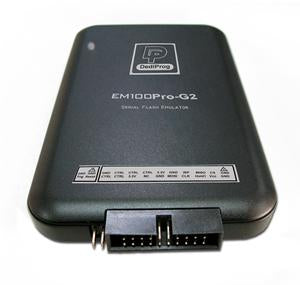






































FlashRunner High-Speed | Any combination supported
FlashRunner High-Speed combines high-level programming performance and high modularity to obtain a multi-end programming solution for Pre-Programming and In-System Programming equipment. Manage big-size data files with up to 80MB/s transfer rate speed for highest programming performance.
The HS Control Unit is the central management for different technologies supported by peripheral Active Modules. The possibility to place the Active Module close to the target devices cuts any distance between the programming system and customer’s board for optimal signal integrity as well as programming many units in parallel.
| Active Modules* | Description |
|---|---|
| General Purpose 2 - GP 2 General Purpose 4 - GP 4 | Flash embedded microcontrollers memories, serial and QUAD SPI memories, CPLD configuration, OTP devices e t c |
| eMMC 1 eMMC 2 | High frequencies and fast 8-bit bus used in eMMC memories |
| NAND** | NAND devices with data bus up to 16 bits |
| CAN** | Both CAN and CAN-FD communications up to 12 Mbps |
| Options: Relays Barrier | Galvanically isolate the target board from the FlashRunner when the programming is completed |
* Any combination of Active Modules supported. The programming system configuration is easily setup in the Workbench GUI software. The overall number of programming channels depends on the Active Module connected. For example: if only GP-4 Active Modules are employed the programmer can support up to 32 target devices in parallel.
** To be released
What's included
- User Manual
- Quickstart guide
- 3-years warranty certification
- FlashRunner HS Control Unit programmer
- Active module of choice
- 15V 40W AC/DC Wall Switching Power Adapter
- Ethernet cross cable 2 meter RJ45
- USB 2.0 cable 1.8 meter (type-A to type-B micro)
- WIKI section with complete documentation for each driver
My AutoQuote | Easy & Fast
Easily generate and keep track of your quotes. You can also place an order based on an active quote. Both Quotes and Orders are organized for you under your account page.
More informationSpecifications
| Programming Sites | Connected to 8 distributed FR HS Active Modules (each one with a programming connector to a programmable device) |
| Protocols | eMMC, NAND, BDM, JTAG, DAP, CSI, SPI, QUAD-SPI, I2C, UART, MC2W, ISSP, SWD, ICSP, EICSP, MDI, PPM, PDI, SWIM and many others |
| Communication Frequency | Up to 50MHz |
| Digital Lines | 8 or 12 Digital communication lines per programming connector according to FR HS Active Module in use |
| Host Interface | Ethernet LAN,1Gbps, micro-USB, Control Interface |
| Dimensions | 170 x 83 x 19 mm |
| Power Supply | 15V DC power jack |
| Power Supplying Features | eMMC Active Module VPROG0: 1.2V – 3.6V @ 300mA VPROG1: 1.2V – 5.5V @ 300mA General Purpose Active Module VPROG0: 1.65V – 5.5V @ 300mA VPROG1: 5.5V – 13.5V @ 300mA |
| ISP Connector | 30 position, 2 row, 1.27mm pitch, vertical or right-angle male connector |
| Dynamic Memory | 1 GB RAM DDR3 memory |
| Static Memory | Up to 256 GB microSD-CARD memory 256 GB on-board eMMC memory |
| Relay Barrier | Power supply and command line provided through programming connector to an external board |
| Voltage and Current Monitor | Yes, continuous monitoring |
| Logging | Via on-board timekeeper and calendar for time-stamped log files |
| LEDs | Status LED and Operation LED for each programming channel |
Product information
| CONTROL UNIT: | |
| Hardware Features |
|
| Software Features |
|
| ACTIVE MODULES: | |
| General Purpose 2 and 4 |
|
| eMMC 1 and 2 |
|
| NAND |
|
| CAN | This module has four parallel independent communications channels. Each one of them is featured by a galvanically isolated transceiver to interface a CAN bus as required by the CAN/CAN-FD protocol specifications. |
| Relays Barrier | There are two models of relay barrier:
|



